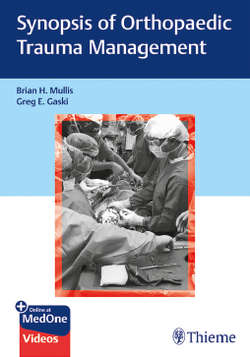Читать книгу Synopsis of Orthopaedic Trauma Management - Brian H. Mullis - Страница 63
II. Influence of Growth Factors and Antagonists on the Phases of Fracture Healing
ОглавлениеA. Inflammatory phase—most important for fracture healing to progress. It starts with injury and is complete within 2 to 3 weeks or earlier (▶Fig. 8.1).
1. Hematoma invasion by macrophages, leukocytes, and lymphocytic cells.
a. Platelets degranulate releasing signaling molecules.
i. Transforming growth factor-beta (TGF-β) and platelet-derived growth factor (PDGF).
ii. Promote chemotaxis, angiogenesis, and proliferation and differentiation of the cells that have migrated to the fracture.
b. Characterized by neovascularization and ingrowth of proliferative blood vessels.
c. Cellular attachment to extracellular matrix (ECM) and conductive substrate occurs. Integrins are membrane receptors that facilitate cell adhesion and attachment.
Fig. 8.1 Time table for the stages of fracture healing. This is a continuum, with all phases occurring in a sequential fashion with each phase overlapping.
Fig. 8.2 Wnt signaling pathway, its antagonists and actions of parathyroid hormone (PTH).
2. Factors influencing the inflammatory phase—arachidonic acid metabolism.
a. Enzymes cyclooxygenase (COX)-1 and -2 metabolize arachidonic acid to prostaglandin.
i. COX inhibitors prevent the production of prostaglandin products. It inhibits all phases of the inflammatory process.
ii. Important to refrain from these medications for the first 2 to 3 weeks post injury until inflammatory phase is complete.
b. COX inhibitors are nonsteroidal anti-inflammatory drugs (NSAIDs). Largest effect on basic science models is either right before fracture or within the first few days following fracture.
c. COX-2 inhibitors target COX-2 which is responsible for inflammation and pain.
d. Targeting selectivity for COX-2 reduces peptic ulceration, but still has fracture healing side effects of NSAIDs and risk for fracture healing.
3. Wnt pathway (▶Fig. 8.2).
a. Wnt are signal transduction pathways made of proteins that pass signals from outside a cell through cell surface receptors to the inside of the cell.
b. Wnt regulates gene transcription conversion of undifferentiated mesenchymal stem cells into an osteoblastic lineage.
c. Induction of the Wnt promotes bone formation; inactivation leads to osteopenia.
i. Sclerostin produced by osteocytes inhibits the Wnt signaling pathway.
ii. Wnt pathway inhibition leads to decreased bone formation.
4. Anti-sclerostin antibody (Romosozumab)—antibodies against sclerostin promote bone formation and increased callous size.
B. Callous phase of healing involves migration, proliferation, and differentiation of chondroprogenitor cells into chondrocytes. Cartilage callus provides immediate mechanical stability and promotes sites for cell attachment and new bone formation.
Fig. 8.3 Receptor activator of nuclear factor kappa-B ligand pathway and mechanism of action for bisphosphates.
1. Factors influencing callous phase of fracture healing (▶Fig. 8.1).
a. TGF-β activates fibroblasts to induce collagen formation, endothelial cells for angiogenesis, chondroprogenitor cells, and mesenchymal cells.
b. PDGF stimulates cellular replication (mitogenesis), increasing cell populations of mesenchymal and osteoprogenitor cells.
c. PDGF activates macrophages resulting in further debridement and triggers a second source of growth factors released from the host tissues by macrophages.
2. Mature callous phase involves mineralization of the cartilaginous callus matrix. Chondrocyte proliferation declines and hypertrophic chondrocytes predominate. Chondroclasts remove the calcified cartilage, and blood vessels develop with perivascular mesenchymal stem cells that differentiate into bone-forming osteoblasts.
3. Remodeling phase (▶Fig. 8.1).
a. Osteoclasts are responsible for fracture callus remodeling.
b. Interaction between osteoblastic and osteoclastic function leads to successful remodeling.
4. Juvenile osteoblasts secrete factors that induce fully differentiated osteoblasts to express ligands that regulate the activity of osteoclasts.
5. Receptor activator of nuclear factor kappa-B ligand (RANKL), found on osteoblasts, activates osteoclasts (▶Fig. 8.3).
a. Osteoclastic activity is triggered by osteoblasts’ surface-bound RANKL activating the osteoclasts’ surface-bound RANK.
b. Activation of RANK by RANKL promotes the maturation of preosteoclasts into osteoclasts.
6. RANKL inhibitor, denosumab prevents maturation of osteoclasts by binding to and inhibiting RANKL.
Fig. 8.4 Radiograph of a patient with a complete atypical femoral fracture. Note the substantially transverse orientation of the fracture line at the lateral cortex, the medial spike, and the generalized cortical thickening.
7. Estrogen inhibits the formation and activation of the bone-resorbing osteoclasts via suppression of RANKL signaling within the osteoclast.
8. Parathyroid hormone (PTH) binds to osteoblasts (osteoclasts do not have a receptor for PTH) stimulating them to increase expression of RANKL.
a. PTH also inhibits osteoblast expression of osteoprotegerin (OPG).
b. The binding of RANKL to RANK stimulates osteoclast precursors to fuse, forming new osteoclasts, which enhances bone resorption.
c. Teriparatide (Forteo) is the recombinant form of PTH. Intermittent use activates osteoblasts more than osteoclasts and leads to an overall increase in bone.
d. Teriparatide is used in the treatment of some forms of osteoporosis.
9. Bisphosphonates inhibit the digestion of bone by encouraging osteoclasts to undergo apoptosis which leads to slowing of bone loss (▶Fig. 8.3).
a. There are two classes of bisphosphonates: the N-containing and non-N-containing bisphosphonates.
i. Non-nitrogenous bisphosphonates (diphosphonates) are metabolized and replace terminal pyrophosphate moiety of adenosine triphosphate (ATP), forming a nonfunctional molecule. It competes with ATP for cellular energy metabolism. ATP loss causes osteoclast death, with decrease in the breakdown of bone.
ii. Nitrogenous bisphosphonates promote inhibition of osteoclast ruffled border with dysfunction of resorption.
b. Long-term bisphosphonate use can result in oversuppression of bone turnover (atypical femoral fractures; ▶Fig. 8.4).
